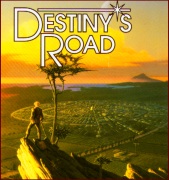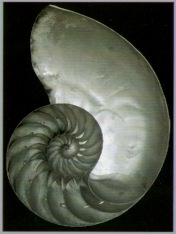

These are the reviews from June through October of 1997. For newer reviews, go back to the main book page.
 The social and technical themes explored in Destiny's Road are
favorites of this author: interaction of earthly and native ecology,
development of society in a remote colony,
loss of technology,
a society's dependence on a single critical resource,
and the efforts of a single individual to change their world.
Niven has written about these themes in several books, including
A Gift from Earth, World Out of Time, and
Legacy of Herot.
This new effort is a completely new and original take on
some of these themes, and quite successful. The reader
is lead skillfully along as the protagonist
gradually discovers the true structure of his society, and
his own roles in it.
The social and technical themes explored in Destiny's Road are
favorites of this author: interaction of earthly and native ecology,
development of society in a remote colony,
loss of technology,
a society's dependence on a single critical resource,
and the efforts of a single individual to change their world.
Niven has written about these themes in several books, including
A Gift from Earth, World Out of Time, and
Legacy of Herot.
This new effort is a completely new and original take on
some of these themes, and quite successful. The reader
is lead skillfully along as the protagonist
gradually discovers the true structure of his society, and
his own roles in it.
While science is not the primary focus of Destiny's Road, it is scientifically sound. The physics, ecology, biology, and astronomy that underpin the background, settings and action are well presented and completely feasible from today's understanding of physical law. Overall, this is one of Niven's most thoughtful and yet accessible novels in years.
Conclusion: Recommended
The players here are the familiar ones: Luke, Leia, Han, et al, with a few recent additions including Callista, a re-incarnated Jedi to whom Luke is very strongly attracted. Leia gets a bigger share of the plot in this novel than most, consonant with Barbara Hambly's committment to strong female characters. The plot is almost formulaic, but well-structured and evenly paced. Unfortunately, the straight-forward nature of the plot leaves the reader with little doubt about the novel's conclusion, the only mystery is how it will unfold. In an effort, perhaps, to draw out the suspense, the ending is rather abrupt; Barbara Hambly is certainly not the only science fiction writer taking this approach.
In short, Planet of Twilight is a pretty good "Star Wars" novel, but only mediocre when compared its contemporaries in the broader science fiction genre.
Conclusion: Recommended for Star Wars fans only
 First, ignore the glitzy cover and marketing hype. This is an
in-depth look at the most widely used programming interface for Windows95
and Windows/NT, the Microsoft Foundation Classes (MFC). Coding for
MFC is much easier than programming at the underlying operating system
interface, Win32.
Even so, it requires a firm grounding in the
fundamentals of the C++ language, and enough experience using
the Windows95 user interface to be able to relate to the problems that
the author sets up and then solves. In keeping with contemporary custom
the book is sold with a CD-ROM that includes the example
programs from the body of the book in machine-readable form.
First, ignore the glitzy cover and marketing hype. This is an
in-depth look at the most widely used programming interface for Windows95
and Windows/NT, the Microsoft Foundation Classes (MFC). Coding for
MFC is much easier than programming at the underlying operating system
interface, Win32.
Even so, it requires a firm grounding in the
fundamentals of the C++ language, and enough experience using
the Windows95 user interface to be able to relate to the problems that
the author sets up and then solves. In keeping with contemporary custom
the book is sold with a CD-ROM that includes the example
programs from the body of the book in machine-readable form.
The foremost aspect of Windows programming that concerns most professionals and hobbyists that approach the system is the mechanics of building user interfaces. Accordingly, the user interface facilities of MFC are covered in the most detail. In general, the author does a very good job of explaining how to construct various kinds of graphical user interfaces, and also explains why they work as they do to a reasonable depth. The example programs are well chosen, and always presented and explained in their entirety. Unlike so many Windows programming books that rely heavily on the assistive features of a particular development environment, Programming Windows95 with MFC emphasizes the code itself.
Unfortunately, this book is not for everybody. The technical depth may too great for the casual programmer, and the unstated assumption of familiarity with Windows95 low-level API features may try the patience of programmers new to the system. However, for the reader approaching it with the right background, this book will be an invaluable resource.
Conclusion: Highly Recommended, for serious programmers only
This medium-size science fiction novel is the third in a series called "The Chaos Chronicles." The structure, characters, and themes are tightly bound to the previous books in the series: Neptune Crossing and Strange Attractors. Jeffrey Carver's writing is sometimes thoughtful and sometimes vigorous, but his style is fairly effective at conveying the feeling of the characters as they are buffeted by the turns of the plot.
In the first and second books, human John Bandicut and his associates have the role of interstellar troubleshooters thrust upon them. This third book is their first assignment, in a sense. The narrative reveals the various conflicts underway on the planet they visit in a measured way, leading the reader through the process of discovery along with the characters. The balance of the story seems awry in a few places, but not seriously so. Overall, the mysteries that confront Bandicut and the characters are very smoothly and logically presented.
While The Infinite Sea is a good read, it does not quite measure up to the second book in the series. The locale and scope of this book are somewhat smaller, and the structure is just not as imaginative. If you read and enjoyed the first two books, you'll also enjoy this one; otherwise, check out Strange Attactors first.
Conclusion: Somewhat Recommended
Among the sciences, it has always seemed to me that biology must be one of the most intricate and most arduous to master. The illogical but fascinating miracle of a living thing draws many into the study of medicine, biology, biochemistry, and related disciplines.
Dr. Cooper's new textbook, The Cell, is intended to provide the first in-depth treatment of molecular biology for the undergraduate college student. While detailed, it is not a stereotypical dry and boring tome. The wonder and complexity of life shines through the book, from its introductory chapters on cell structure to its closing discussion of the mechanisms of cancer.
 This text is accessible both to studious pre-meds and to the
well-prepared layperson. The writing is quite clear, and the
use of technical terminology consistent and reasonable. Fortunately,
the emphasis of the entire book is not on the chemistry of cellular
operation, but on the functional and structural nature of cell
processes and the molecules that drive them.
This text is accessible both to studious pre-meds and to the
well-prepared layperson. The writing is quite clear, and the
use of technical terminology consistent and reasonable. Fortunately,
the emphasis of the entire book is not on the chemistry of cellular
operation, but on the functional and structural nature of cell
processes and the molecules that drive them.
Another real attraction of The Cell is its beautiful illustrations. The precise and clear diagrams are well integrated with the text, and the photos are also very informative. The glossary and index are very good.
As a college text, this book employs a lot of pedagogical devices aimed at the student. Chapters are cleanly divided into sections, and each chapter ends with summary points, terms, and exercises. Unlike many texts, however, the main flow of the material is sprinkled with page-long inserts explaining classic experiments and medical discoveries. These inserts help give the reader a feeling for how molecular biology relates to medicine and, ultimately, human life.
My edition of The Cell was accompanied by a CD-ROM. The disc provided animations and additional diagrams to supplement the text. The CD is not a great one, but it is a nice little addition to the book, and may be a useful on-line reference for students preparing papers.
This book is not for everyone, however. It is not well-adapted to
casual browsing, and some readers may be daunted by its size
and level of detail. Approached with enough perseverance, however,
it is a very rewarding book.
Conclusion: Recommended
This complex story is a fine first effort, and a good cross-over read for fans of near-future science fiction and for fans of espionage novels. The pace of the book is very fast, but well-placed flashbacks keep it from being overbearing.
The main character of Looking for the Mahdi is a hard-bitten journalist named K.B. She gets trapped into escorting a genetically engineered humanoid named Halton into a backward, repressive middle-eastern country. Her experiences there from a prior assignment don't bode well for the trip, and, as expected, intrigue and violence soon erupt around the pair. The plots and conspiracies are twisted, clever, and credible.
The only distraction from the engaging story is the main character's relentless cynicism and disgust with government. It seems, at times, that the author is attempting to present some social commentary, but if so it is rather heavy-handed.
Conclusion: Recommended

The plot of this book is a little bit difficult to describe; it is really two intertwined plots that dance around each other, slowly gravitating toward the end of the book when they terminate the story by touching.
Set in Tokyo sometime in the near future, this novel relates the progress of a trancendental upheaval in the life of a talented and aloof data security technician. Unlike a lot of American cyberpunk science fiction, the speculative science in the story does not overpower the rest of the book. Instead, the science serves the deep themes of discovery and loss. Despite the somber tone of much of the writing, the story is immediately and completely involving. The protagonist is presented in marvelous detail, and by the time he begins to face real difficulties in the latter portions of the book you feel drawn to discover how he fares.
The English translation, by Alfred Birnbaum, is idiomatic and completely transparent. It was interesting, for some parts of the book, to have actually been to Tokyo, but it certainly isn't essential.
Conclusion: Highly Recommended
All reviews (c) 1997, Neal Ziring. Reviews may be reproduced in whole or
in part as long as authorship credit is preserved.
[Ziring
MicroWeb Home] [Neal
Ziring] [Julie
Ziring]
[Ziring Guestbook]
This page written by Neal Ziring, last modified 11/10/97.